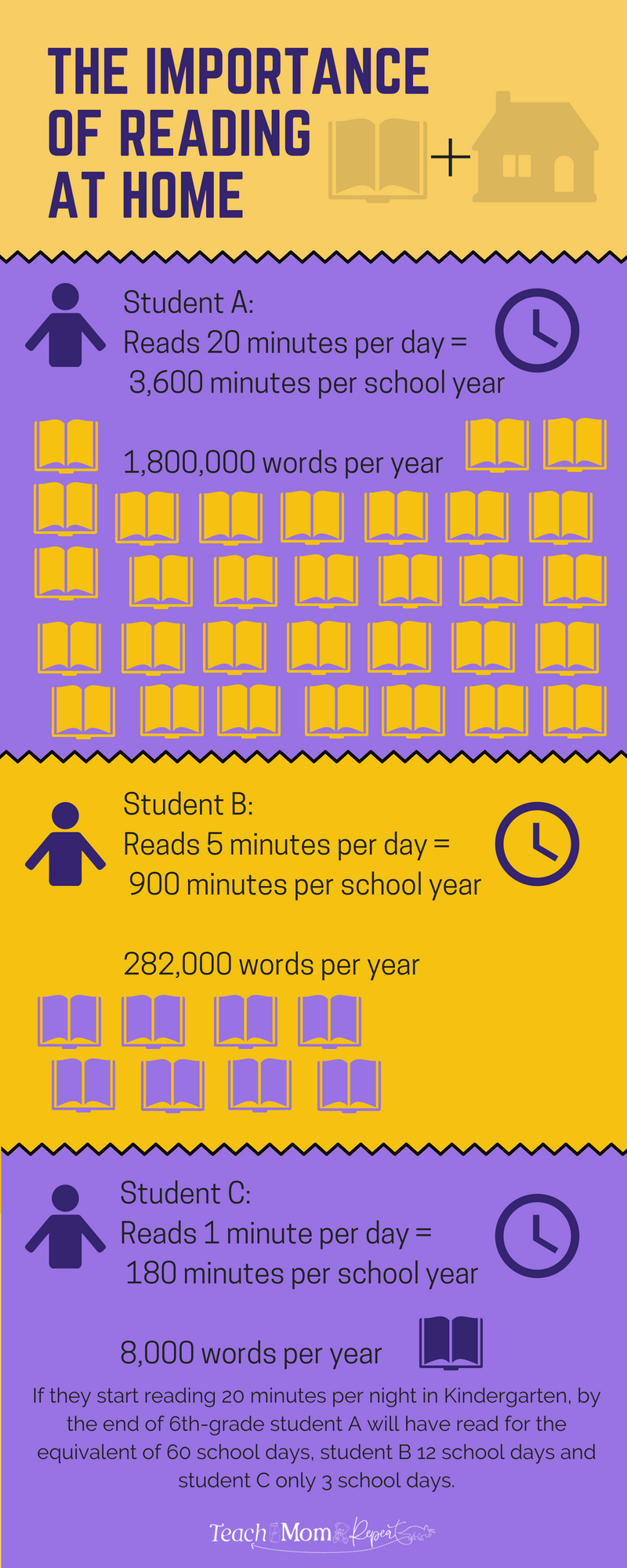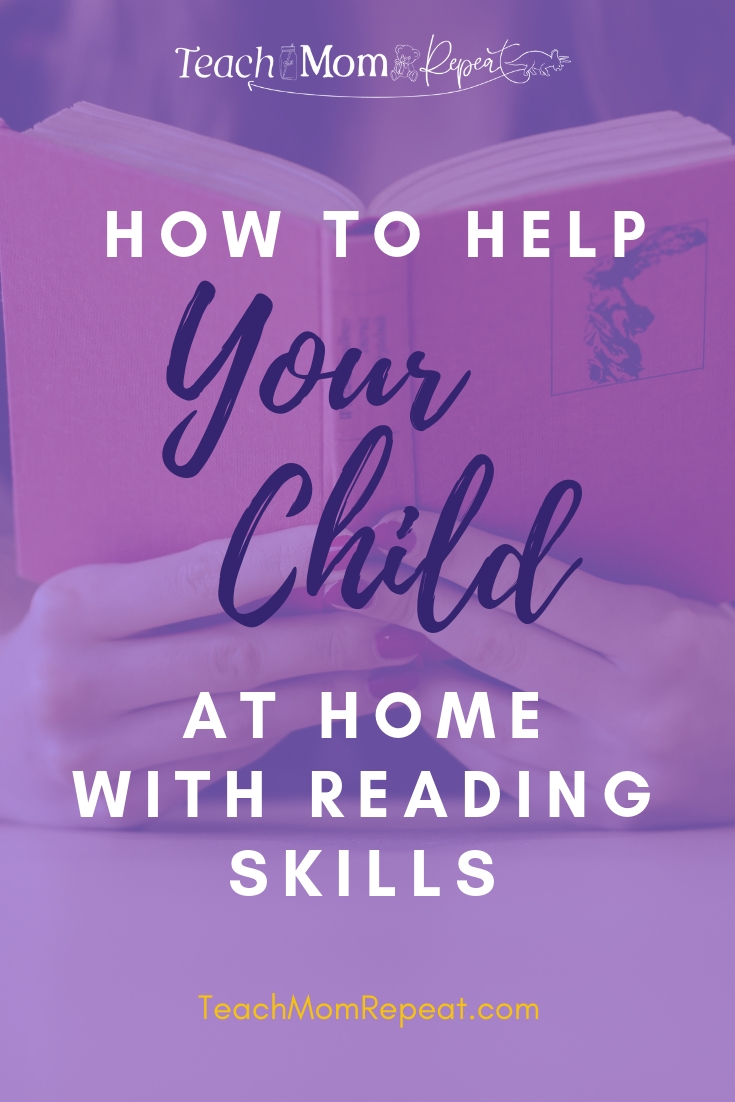
3 Ways to Help Your Child Be a Better Reader
Parents ask me all the time, “How can I help my child be a better reader?” “What can I do at home to help my child be a better reader?” The simplest answer to this question is READ. Read with them. Read to them. Read a page then have them read a page. READ. READ. READ. Let them see you reading, even if it’s the newspaper, magazines or work emails. Show them that reading is a life skill. This really helps them to understand why it’s important to learn reading skills.
When we discuss reading accountability at the start of the school year I share an infographic with students that illustrates the importance of reading. It explains that reading for at least 20 minutes a day during the school year will expose them to over a million words. Exposure to words is how we all get better at reading. Vocabulary is key. Knowing the meaning of words allows us to comprehend what we read. Knowing strategies for figuring out unknown words while we read is also a skill good readers possess.

Some of the links found in this post are affiliates. This means if you make a purchase after clicking through we will receive a small compensation at no extra cost to you. Thank you in advance for your support and please know that we only endorse products we use and love.
So the simplest way to become a better reader is to practice it. Just like any other skill. Professional football players still show up to practice because even they can become better at their game. (Unless you play for the Browns!) I share a personal example with the kids that demonstrates even really good readers still need to look up unknown words.
When I read Wonder I had never heard the word precept before; I understood the concept from the story but had never known the meaning of the word. Once I looked it up I realized that my understanding was slightly off and with the true meaning I understood the author’s intent more clearly. Has this ever happened to you? Share that with your child or students. Show them there is always an opportunity to learn new words.

While reading at home is an important way to become better at reading it’s not the only way to help increase reading skills. Here are 3 activities to practice with reading, as well as a few websites and apps that can help.
1. Depth of Knowledge
The simplest comprehension questions ask us to recall important facts. If we can read something and then share the important parts then we have successfully comprehended the story. However, students often struggle to determine what’s important and what’s just part of the story. Characters and their actions that move the story forward are important. If a character stops to buy candy at the gas station it could be to show us that they have a sweet tooth, or share insight to the setting, or to have them interact with another important character. If they simply stop to buy candy and move on then there isn’t much important in that. However, students who connect to behaving similarily can feel like it should be important when it’s not.
Ask your child to recall the important parts of the story from the chapter or section that they just read. If it sounds like it may not be important to the overall story probe them for why they feel that was an important part. If they can defend it to show significance this is great practice for comprehension.
Being able to articulate why a character made a decision or acted in the way they did helps students see the big picture.
2. Vocabulary
If students are reading out loud and stumble on a word saying it for them is good. But then ask if they know what it means. Sometimes we just need to hear a word in order to recognize it; making exposure to words such a vital part of becoming a better reader. If they can’t tell you the meaning ask them if the context around the word can help them figure it out. Still unsure or can’t figure it out? Looking up the word in the dictionary is necessary. Find a place in the house where you can write these words so your child will see them daily that can also help. It takes several times seeing a word and thinking about what it means before we add it to long-term memory.
A few websites that are good for simple word practice include:
Vocabulary.com *also has an app called PowerVocab
There are also several phone apps that are free word games. Any word game that is not just spelling words will help increase vocabulary. One that is great for middle school is called The World’s Worst Pet. It’s a strange name for an app, but it has helpful games to learn new words. You can also choose the level of words and increase as kids gain more knowledge.
3. Reading Websites
There are several websites that provide reading practice for kids whether they are in a classroom or at home. Often they require a login and have paid versions, but they also usually allow for free features as well. Here are some of my favorite sites:
ReadWorks.org is geared towards teachers, but their Article-A-Day option is great for at home practice. Many of the sites are geared towards teachers who use these in their classrooms, but it’s just as easy for a parent to set up an account.
FunBrain.com is a great site for books online and reading games. They offer searches by grade level from Pre-K to 8. There are also vocabulary games as well as other subject areas available.
LearnOutLoud.com is a great place to find free audiobooks. Titles are mostly classic books, but those can be very exciting. When listening to an audiobook it is always best to have the physical book to look at while listening. This helps kids engage with the vocabulary.
Newsela.com is a current event website that allows students to read nonfiction at their level. The site is geared for teachers to use in their classrooms, but this can be accessed at home as well. You will need to create an account to access the content. Although it’s not the site’s intent, parents can easily create an educator account and add their child or children to a class you call Home. If your child’s teacher is already using this site then ask if they would assign articles for your child to practice at home.
There is a navigation tool on the left that allows you to choose a child’s level by grade and then narrow by skill. If your child’s teacher has expressed a specific area they need to practice this is a great way to zero in on that particular skill. Kids can search for a topic that is of interest to them, which will help them engage with the reading. After each article, there is a quiz for students to take. You can track their progress in your account and celebrate their growth!
Finding support for helping our older children be better readers can often be a difficult task. There is a plethora of support for young, emergent readers but there are very few options to help our tweens and teens. It’s assumed that by the time they get to be this age they are fluent readers, but that’s not always the case. Books can often be a turn off for older students if they haven’t been able to find one they enjoy. The resources above should help to make reading easier for them and an activity they can hopefully enjoy. If you’re looking for popular book suggestions here are 50 for the secondary student.
Teacher friends, share your greatest resources that you suggest to help parents help their children.
Moms, what is your child’s greatest struggle with reading? Share the strategies you’ve used at home that have helped. Want to receive great mom resources and freebies straight to your inbox? Drop your email in the form below.

